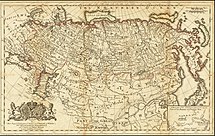Russian Republic
| 1917–1918 | ||
| Anthem: Рабочая Марсельеза Rabochaya Marsel'yeza "Worker's Marseillaise" Гимн Свободной России Gimn Svobodnoy Rossii "Anthem of Free Russia" (Unofficial) | ||
| Government Seal: Minister-Chairman | | |
• September–November 1917 | Alexander Kerensky[c] | |
• 1917–1918 | none[d] | |
Chairman of the Constituent Assembly | ||
• 18–19 January 1918 | Viktor Chernov | |
| Legislature | Provisional Council (1917) none (1917–1918) Constituent Assembly[e] (1918) | |
| Historical era | World War I / Russian Revolution | |
| 10–13 September 1917 | ||
• Republic proclaimed | 14 September 1917 | |
| 7 November 1917 | ||
| 25 November 1917 | ||
• Constitution adopted | 18 January 1918 | |
• Constituent Assembly dissolved | 19 January 1918 | |
| Currency | Ruble | |
| History of Russia |
|---|
 |
|
|
The Russian Republic,
The
The Bolsheviks also used the name "Russian Republic" until the official name "
History
Following the
Officially, the Republic's government was the Provisional Government, although
During his first weeks as prime minister, Lvov presided over a series of fleeting reforms which sought to radically liberalize Russia. Universal adult suffrage was introduced, freedoms of press and speech were granted, capital punishment abolished, and all legal restrictions of religion, class and race were removed.
The Government's control of the military was tenuous. Seamen of the
Following the failure of Kornilov's coup, Kerensky proclaimed Russia to be a Republic on 1 September, establishing a Provisional Council as temporary parliament, in preparation to the elections of a Constituent Assembly. However, on 7 November 1917, the Bolsheviks seized power and dissolved both the Provisional Government and the Provisional Council.
Nonetheless, a
The Republic de jure continued to exist until the Bolsheviks proclaimed the creation of the
Principal institutions
- Provisional Council of the Russian Republic
- Congress of Soviets
- Russian Provisional Government
- Directorate (Russia)
See also
- Russian Empire
- Russian Civil War
- Soviet Union
- Petrograd Soviets
- World War I
- Bolshevists
- Elections in Russia
Notes
- ^ Pre-Reform Russian:Россійская Pеспублика
- ^ Pre-Reform Russian: Россійская Демократическая Федеративная Республика
- ^ Served as the prime minister of the provisional government from July 1917
- ^ De facto power seized by the Bolsheviks led by Vladimir Lenin
- ^ Dissolved after the very first meeting
- ^ Russian: Российская Республика, tr. Rossiyskaya Respublika, IPA: [rɐˈsʲijskəjə rʲɪsˈpublʲɪkə].
- ^ Russian: Российская Демократическая Федеративная Республика, tr. Rossiyskaya Demokraticheskaya Federativnaya Respublika.
References
- ^ The Russian Republic Proclaimed at prlib.ru, accessed 12 June 2017
- ^ a b Ikov, Marat Sal. "Round Table the Influence of National Relations on the Development of the Federative State Structure and on the Social and Political Realities of the Russian Federation". Prof.Msu.RU. Retrieved 9 February 2021.
However, historically, the first proclamation of the federation was made somewhat earlier - by the Constituent Assembly of Russia. In his short resolution of January 6 (18), 1918, the following was enshrined: "In the name of the peoples, the state of the Russian constituent, the All-Russian Constituent Assembly decides: the Russian state is proclaimed by the Russian Democratic Federal Republic, uniting peoples and regions in an indissoluble union, within the limits established by the federal constitution, Of course, the above resolution, which did not thoroughly regulate the entire system of federal relations, was not considered by the authorities as having legal force, especially after the dissolution of the Constituent Assembly.
- ISBN 9780593493885.
- ISBN 9781448112647. Retrieved 22 May 2021.
- ISSN 2409-868X.
External links
- The Russian Republic proclaimed. Presidential Library
- Browder, R. P., ISBN 9780804700238


